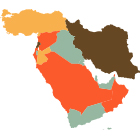Third Party Monitoring & Evaluation of EU non-humanitarian assistance in Syria
Background:
The Syrian conflict, which began in 2011, has emerged as one of the most devastating humanitarian crises in recent history. The European Union (EU) initially engaged in bilateral cooperation with the Syrian government but suspended these collaborations in response to the violent suppression of civilian uprisings by the regime. Instead, the EU redirected its efforts towards providing assistance to the Syrian population while adhering to stringent EU sanctions against designated individuals and entities involved in the Syrian situation, as outlined in Council Regulation (EU) No 36/2012.
The situation within Syria is dire, with approximately 13.5 million people, including 6 million children, in urgent need of humanitarian aid. Alarmingly, nearly 4.6 million individuals reside in hard-to-reach areas, with approximately 500,000 people trapped in besieged regions. The conflict has profoundly impacted Syria’s development, pushing it back nearly four decades. A staggering 85% of Syrians now live in poverty, and the crisis has caused a drastic drop in life expectancy by over 20 years while pushing more than 1.75 million children out of school. Additionally, Syria has regressed in all 12 Millennium Development Goal indicators, and the economy has contracted by an estimated 40% since 2011, leading to widespread loss of livelihoods.
The EU’s approach towards Syria has shifted towards pressuring the government to cease violence and fostering a political resolution to the conflict. The EU, as a member of the International Syria Support Group, is actively participating in UN-led processes, emphasizing the importance of peace and stability for the Syrian people. European Union funding for the Syrian crisis has been substantial, with over €3.8 billion allocated since 2011. This assistance encompasses humanitarian aid and non-humanitarian support, addressing both immediate and medium-term needs. In humanitarian aid alone, the EU has contributed €1.45 billion, covering life-saving emergency responses, food, water, sanitation, hygiene, and shelter for millions of Syrians inside the country and in neighboring regions.
Triangle’s Assessment:
- Conflict Dynamics Analysis: A critical component of the assessment involved analyzing the conflict dynamics within Syria. This included assessing the evolving nature of the conflict, identifying key actors and their interests, and understanding the broader socio-political context.
- Impact on Conflict Reduction: The assessment delved into the extent to which EU assistance projects have contributed to conflict reduction. This included examining tangible outcomes, such as reductions in violence or improved stability, and intangible impacts on peacebuilding efforts.
- Promotion of Social Cohesion: Another key aspect of the assessment was evaluating how EU-funded initiatives have fostered social cohesion within Syrian communities. This included assessing efforts to bridge divides, build trust, and promote dialogue among different societal groups.
- Value Added of EU Assistance: The assessment also considered the value added by EU non-humanitarian support in Syria. This entailed examining how EU assistance has differentiated itself from other aid efforts and whether it has effectively addressed the unique needs and challenges of the Syrian context.
- Conflict Sensitivity: Throughout the assessment, a central focus was placed on the conflict sensitivity of EU assistance. This involved evaluating whether the projects have been mindful of potential negative impacts on the conflict and whether they have incorporated conflict-sensitive approaches into their design and implementation.
Project:
Third Party Monitoring & Evaluation of EU non-humanitarian assistance in Syria

Duration:
January 2019-December 2020
Lebanon
